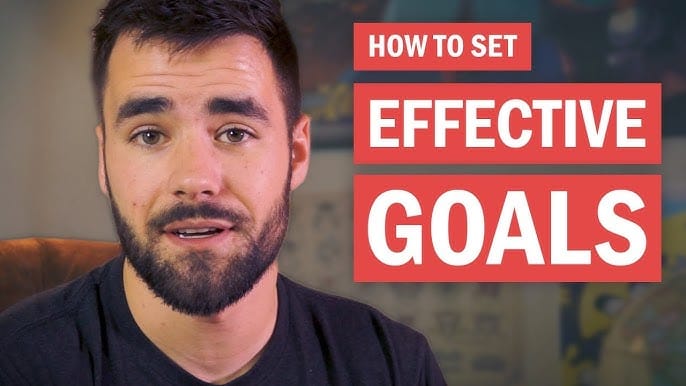Everyone wants to have more money or Set Money Goals, but without a plan, it’s easy to feel lost. That’s why setting money goals is super important. When you know exactly what you’re working toward, it helps you stay focused, spend smarter, and feel more in control of your life. Whether you want to save for a car, get out of debt, or build an emergency fund, money goals give you a clear path. Reaching them can also reduce stress and make your future way more secure.
The problem is, most people say things like “I want to save money” or “I need to pay off debt” without a real plan. These kinds of goals are too vague, and people often give up because they don’t know where to start or how to track progress. Without specific steps, it’s easy to lose motivation and quit halfway.
In this guide, you’ll learn how to set clear, realistic money goals you’ll actually stick with. We’ll go over easy tips to help you stay on track, build strong habits, and feel proud of your progress. Whether you’re just starting out or want to fix old money mistakes, this article is for you.
Understand Your ‘How’
Before setting any money goal, you need to ask yourself one simple question: How does this goal matter to me? Your reason should connect to something personal. For example, maybe you want to save money not just to have cash in the bank, but so you can move out of your parents’ house and live on your own.
That goal feels more real because it’s tied to your desire for freedom and independence. When you link your money goals to real-life dreams, it becomes way easier to stay focused and not give up. It’s not just about dollars it’s about what those dollars can do for your life.
Let’s say you’re working part-time and want to save $3,000. That might feel boring or hard to stick with. But if you tell yourself, “I’m saving $3,000 so I can buy my first car and stop relying on others for rides,” it suddenly feels more exciting and personal. Now, each dollar saved gets you closer to something you truly care about.
This emotional connection is what keeps people going, even when it’s tough. So take time to think about your real reason—your why before chasing any money goal. It’s the foundation for long-term financial success.
Assess Your Financial Starting Point
Before you can set smart money goals, you need to know exactly where you stand with your finances. That means taking a clear look at how much money you earn, how much you spend, what debts you owe, and how much you’ve already saved.
Think of it like using GPS. You can’t get directions to your destination if your phone doesn’t know your current location. The same goes for your personal finance journey. Without knowing your starting point, it’s easy to feel stuck or confused. Many people skip this step and set goals that are way too big or not even possible right now.
One easy way to get started is by using free budgeting apps or a simple spreadsheet. Just list your income from your job, side hustle, or allowance. Then track your regular expenses like food, gas, streaming subscriptions, and other bills.
Don’t forget to write down any credit card debt or student loans. Add up your savings too, even if it’s just a few dollars. When you see everything in one place, it becomes easier to spot where your money is going and what needs to change. This simple step builds confidence and helps you set realistic goals that actually match your lifestyle.
Use the SMART Goal Framework
If you want to set money goals that actually work, try using the SMART goal method. SMART stands for Specific, Measurable, Achievable, Relevant, and Time-bound. Instead of saying something like “I want to save money,” you could say “I want to save $1,200 in 6 months.” That’s specific. It gives your brain something real to focus on. When your goal is clear, it feels more serious and possible to reach.
Next, your money goal should be measurable. This means you can track how close you are to your goal each week or month. For example, if you want to save $1,200 in 6 months, that’s $200 a month. You can write it down or use a money-saving app to track your progress.
Seeing your savings grow step-by-step helps keep you motivated. It’s also important that the goal is achievable. Don’t try to save $5,000 in a month if you only make $1,500. Make sure the goal fits your lifestyle and income.
Your goal also needs to be relevant to your life and time-bound. Ask yourself if this goal helps your future, like saving for a phone, college, or emergency fund. Then give yourself a deadline. A money goal without a finish date is easy to forget. SMART goals make it easier to stay focused and actually follow through.

Break Big Goals into Mini Milestones
One of the biggest reasons people give up on money goals is because the goal feels way too big. Like if you want to save $1,200, that number can feel super scary, especially if you are just starting out with saving.
That is why breaking big goals into smaller parts is so helpful. When you turn a big goal into tiny steps, it does not feel so hard. It’s like climbing stairs instead of trying to jump to the top all at once. It makes your money goal easier to manage and less stressful.
Let’s say you want to save $1,200. Instead of trying to do it all at once, make a plan to save $100 a month for 12 months. That sounds way more doable, right? You can even go smaller and aim for $25 each week.
These are called mini milestones. They help you see your progress faster, and that feels really good. Every time you hit a mini milestone, you know you’re closer to your big goal. That kind of progress keeps you going.
Also, don’t forget to celebrate your small wins. You don’t have to buy anything expensive. Maybe just treat yourself to a movie night or a special snack when you hit your goal for the month.
Little rewards help keep saving money fun and exciting. When you break big goals into smaller ones and enjoy the journey, you’re more likely to stay committed and actually reach your savings target.
Automate Your Progress
If you want to reach your money goals faster, automation is your secret weapon. Automating your savings or debt payments means setting things up so they happen on their own without you having to think about it every time.
Let’s be honest, relying only on willpower doesn’t always work. You might forget, get lazy, or just spend the money before saving it. But when money moves automatically, you stick to your goal without even trying that hard.
For example, you can ask your bank to set up automatic transfers from your checking account to your savings account right after you get paid. Some jobs even let you split your direct deposit, so part of your paycheck goes straight into savings.
That way, you never even see the money, and you won’t be tempted to spend it. If you are paying off credit cards or student loans, you can set up auto payments too. This helps you avoid late fees and builds a strong money habit.
There are also budgeting apps that help automate your progress. Apps like Mint, YNAB, or Chime round up your purchases and save the spare change. These small moves can add up fast. When you automate your personal finances, it makes saving money feel way easier.
You’ll build momentum and hit your money goals without stressing every week. Automation helps you stay consistent, which is the real key to long-term financial success.

Track and Adjust as Needed
Once you start working toward your money goals, it’s super important to check in with your progress. You can do this by doing a simple monthly review. Just look at how much you’ve saved, what you’ve spent, and how close you are to reaching your goal.
This helps you stay on track and notice any problems early. It is kind of like checking your grades during the school year instead of waiting for report cards. The more often you check, the easier it is to fix things before they get worse.
Sometimes life throws curveballs. Maybe your car breaks down or you lose a part-time job. If that happens and your plan gets off track, don’t panic. It’s okay to adjust your goals. You can always lower your savings amount for a month or give yourself more time. What matters is that you keep moving forward.
Being flexible with your personal finance plan keeps you motivated and helps you avoid giving up completely. Remember, even small progress is better than no progress at all.
Your life changes, so your money goals should change too. Maybe you were saving for a gaming console, but now you want to focus on building an emergency fund instead. That is totally fine. Goals are not set in stone. By checking in and adjusting your plan when needed, you stay in control of your financial journey and make smarter decisions over time.
Create Accountability
One of the best ways to stick with your money goals is to not do it alone. When you tell someone about your goal, it becomes real. That person can be a friend, family member, or even a money coach. You don’t need to share every little detail, just enough so they can cheer you on or remind you to stay on track.
For example, if you tell your friend that you are saving for a new laptop, they might help you skip eating out so you can save that extra money. It feels good when someone supports your goal.
You can also join online groups or money-saving challenges on social media. There are tons of people working on personal finance goals just like you. It helps to know you are not alone. You can post your progress, get tips, or even ask for help if you feel stuck.
Being part of a community can give you motivation and new ideas to make saving or budgeting easier. Plus, seeing others succeed makes you want to keep going too.
Accountability makes a big difference because it pushes you to follow through. You might skip a goal if only you know about it, but you are more likely to stick with it if someone else is watching. Whether it is a friend or an online group, having accountability turns your money goals into real habits that last.

Reward Yourself Along the Way
Working toward a money goal takes time and effort, so it is important to reward yourself along the way. But here’s the trick — your reward should not mess up your savings. That means choosing small, low-cost or even free things that still make you feel good.
For example, if you save fifty dollars in a week, you could treat yourself to a movie night at home, a relaxing walk at the park, or just a chill night playing video games guilt-free. These little breaks give your brain something to look forward to without spending the money you just saved.
Celebrating mini milestones helps you stay excited and motivated. Imagine you are saving five hundred dollars to buy a new bike. Every time you hit a one hundred dollar milestone, give yourself a small reward.
It could be watching your favorite show, baking something fun, or even just posting your progress on social media. It feels good to be proud of your hard work, and rewarding yourself reminds you that saving money is not just about sacrifice it is also about winning.
If you skip rewards, saving money can start to feel boring or like a chore. But when you add small celebrations, you turn it into something fun and positive. It keeps your energy up and makes your money journey more enjoyable. Rewards help build strong saving habits that actually last, and that is the real goal.
Conclusion
Setting and sticking to your money goals is 100% possible if you approach it with clarity, structure, and commitment. By understanding your why since beginning, breaking down big goals into smaller steps, and using tools like automation, you create a clear roadmap that makes saving money feel manageable.
It’s not about being perfect. It’s about staying consistent and adjusting when life gets in the way. With the right mindset and strategy, anyone can achieve their financial goals, no matter how big or small.
Remember, you don’t have to tackle everything at once. Start with one small goal, and as you see progress, your confidence will grow. Whether it’s saving for a new phone, paying off a debt, or building an emergency fund, you have the power to make it happen.
Use the tips shared here to create your plan, and take that first step today. The sooner you start, the sooner you’ll see the results you want.
So, pick one goal and get started. Whether it’s saving a specific amount each month or setting up automatic transfers, take action now. The journey to financial success doesn’t happen overnight, but with small steps, you’ll be well on your way to achieving your money goals. Keep yourself accountable, reward yourself along the way, and remember that every little progress counts.





